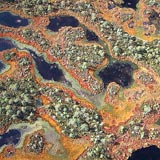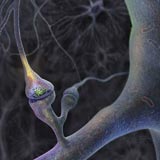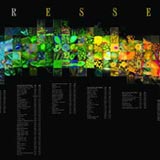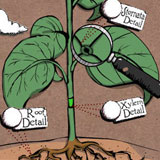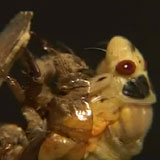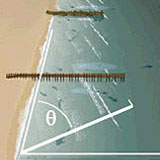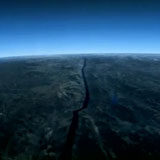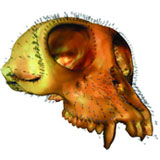
VISUALIZATION CHALLENGE
2005 Winners
Captions from C. Gramling, Science 309: 1989-1993 (2005). Full story in Science magazine.
Photography
First Place
Autumn color, Estonian Bog
Professor James S. Aber, Emporia State University
With its intricate patterns-within-patterns and striking colors the winning photograph bears a distinct resemblance to a fractal. But scale back to about 150 meters above the ground and the sinuous landforms of Estonia's Mannikjarve bog begin to reveal themselves. In the peat bogs of east-central and southwestern Estonia, the autumn works a change in the color scheme: Cotton grass turns gold, hardwoods in surrounding forests turn orange and red, and pine trees remain silvery green. The bog water, is sharp contrast, stays an acidic brown. Geologist James Aber of Emporia State University in Kansas recognized the potential beauty in the landscape and used a digital camera in an unusual setting to capture it.
Illustration
First Place
The Synapse Revealed
Graham Johnson, Graham Johnson Medical Media
Deep inside the brain, a neuron prepares to transmit a signal to its target. To capture that expectant, fleeting moment with painstaking detail, science illustrator Graham Johnson based his elegant, highly accurate drawing on ultra-thin micrographs of sequential brain slices. The brain contains billions of neurons, whose network of chemical messages form the basis of all thought, movement and behavior. Johnson's illustration tells the story of one such signal, a synaptic millisecond that is both eye-catching and accurate in scale and shape. (For more about Graham Johnson, see the journal Science.)
Informational Graphics
First Place
Fluoressence: The Essence of Fluorescence
Cheryl Aaron, Omega Optical, Inc.
A mosaic of colors and flares: All this, and emission peaks too? The winning rainbow of light-sensitive molecules can both spice up a drab laboratory wall and provide a quick reference guide for fluorescence microscopists. "It was a wonderfully intelligent approach to putting all of this information in one place" and also "quite beautiful", says panel of judges member Felice Frankel.
Interactive Multimedia
Honorable Mention
Transpiration: Water Movement Through Plants
Tracy M. Sterling, New Mexico State University
How does a garden grow? Transpiration, the transportation of water through plants from soil to leaves to atmosphere, is an essential part of the hydrologic cycle. From water absorption through a plant's roots to water vapor lost through its leaves, weed physiologist Tracy Sterling of New Mexico State University and animator Matt Byrnes created a friendly interactive activity with a playful design. The animation teaches plant biology basics and offers numerous interactive features, such as changes to environmental conditions that impact the speed of water movement. And that affects how the garden will grow.
Noninteractive Multimedia
First Place
Return of the 17-Year Cicadas
Roger Hangarter and Samuel Orr, Indiana University
They're Baaack. Plant biologist Roger Hangarter and student, Samuel Orr, of Indiana University in Bloomington knew the cicadas were coming, but the pair didn't intend to document the event until the insects began to emerge, spectacularly, in Hangarter's own backyard. The resulting five-minute film (whose original length is 17 minutes) was "a discrete, elegant package, beautifully photographed and very detailed", says panel of judges member Thomas Lucas.
Honorable Mention
Planetary Motion from Eudoxus to Copernicus
Mogi Massimo Vicentini, Civico Planetario Di Milano
Though the early astronomers took an Earth-centric view of the heavens, Italian graphic designer Mogi Massimo Vicentini put the viewer at the center of a sweeping story of planetary motion. Planets rotate, oscillate and appear to move backwards as faulty ideas are rejected, until their motion is most satisfactorily explained by Copernicus' (and Kepler's) heliocentric model. Designed for general planetarium audiences at the Civico Planetario Di Milano in Italy, the presentation is a twirling visual history of planetary exploration and time.
Honorable Mention
Rip Currents: Nearshore Fundamentals
Rip Currents: Nearshore Fundamentals
Steve Deyo, Kevin Fuell, Katherine Olson, Dan Riter and Seth Lamos, UCAR/COMET
Is it safe to go in the water? For the answer, weather forecasters can watch this animated guide to rip currents for the right or wrong combination of nearshore circulation and wave dynamics.
Honorable Mention
Forces of Nature
Evan Ricks and Tim Sassoon, National Geographic TV & Film
Deep under Istanbul, pressure is growing. In the depths of Turkey's North Anatolian fault line, tectonic plates shift and lock, periodically building and releasing stress as destructive energy. In a computer animation based on actual data and models for the fault line, filmmaker Leslie Ann Aldridge of National Geographic TV & Film takes the viewer right down into the fault, creating the forces behind 60 years of episodic earthquake history and suggesting where the next earthquake will occur.
Honorable Mention
Evolutionary Morphing: Statistical Interpolation of Ancestral Morphology Along an Evolutionary Tree
Nina Amenta and David Wiley, University of California, Davis; Eric Delson, City University of New York; F. James Rohlf, State University of New York, Stony Brook; and colleagues
Until the right bones are found, computer-visualized virtual fossils can fill in some evolutionary gaps. By precisely relating landmark points on one skull image to similar points on another, computer scientist Nina Amenta of the University of California-Davis and colleagues calculate hypothetical 3-dimensional ancestors within an evolutionary tree. The resulting video is a transformative, graceful look into monkey morphology, culmination in an evolution of one common ancestor's cranium through five branches of descendants.



